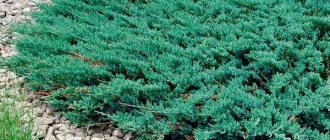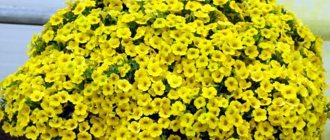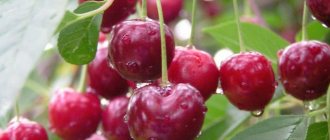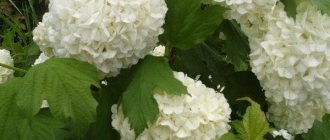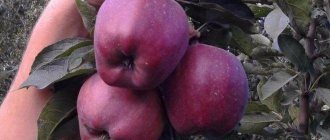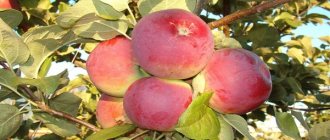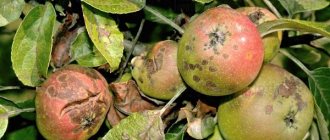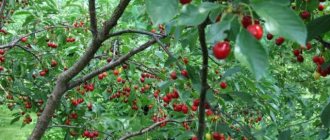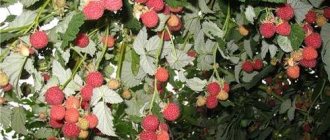Description of the plant
The plant belongs to the Euonymus family and is found naturally in the Far East, Japan, Korea and China. It was brought to Europe in the 19th century and has since become widespread.
The scientific name of the species is Euonymus japonicus; in everyday life, the plant is called “pseudolaurel” for the similarity of the decorative foliage to the spice. In nature, the height of an adult tree or bush reaches 7 m. At home, the crop grows to a maximum of 70–80 cm.
A compact shrub or subshrub that grows dense foliage. The leaf blades are leathery, dense, with an uneven or finely toothed edge, a yellow or white border on a green background. The growth of shoots is directed upward at a slight angle, which forms a raised, rounded crown. The annual growth of branches is 15–20 cm.
The bush blooms in July. Umbrella inflorescences are formed by small greenish or yellowish flowers. In September, fruits appear on the branches - a leathery capsule, often with an edge or winged. The color is bright, yellow or red. Inside the fruit there are small seeds covered with a soft apex.
The shrub tolerates unfavorable external conditions quite well: it does not mind air pollution, shading, or small plot sizes - even in such conditions, the euonymus manages to grow well.
It is worth knowing that Japanese euonymus is poisonous, so children and pets should not be allowed near it. Despite its toxicity, the plant is used in folk medicine. Can be grown in open ground and in apartment conditions.
Use in landscape design
An evergreen shrub with brightly colored foliage looks great when planted alone. A hedge made from Japanese euonymus will look unusual and original. The plant withstands pruning well and can be an object of topiary art.
The crop can become the center of a site in a mixed planting consisting of several varieties with different foliage colors. In landscape design, evergreens are often planted surrounded by ground cover crops that bloom at different times. For example:
- hellebore - white flowers bloom in early spring;
- anacyclus - flowering time July-August, baskets look like daisies in a pale pink shade;
- adonis is a primrose, bright yellow flower heads appear from under the snow, and then foliage;
- Evening primrose blooms in mid-summer, its petals are colored white, pink or yellow.
Many shrubs and flowering perennials have similar requirements for growing conditions as euonymus. On the list of good neighbors:
- snowberry;
- bergenia;
- chaenomeles;
- honeysuckle;
- gypsophila;
- Iberis;
- weigela;
- rose stock;
- iris.
Popular varieties of house plants
Types and varieties of euonymus grown at home (description with photo):
- European euonymus is a bush-like tree up to 6 m tall, in which adult branches have a black tint, and young green shoots have cork growths. The leaves are large, leathery, and turn red in autumn. The ripe fruit is dark pink and orange. The species tolerates frost, drought and polluted air well;
- Euonymus compactus (dwarf) – no more than a meter tall. The variety is known for its small (up to 4 cm long), leathery, light green leaves, the tips of which become sharply pointed and the edges are slightly curved downwards. The leaves below are olive or bluish-green. There is almost no trunk, thin shoots. The plant is often formed as a bonsai and used in interior design. It loves watering, shade, is often susceptible to pests, and does not tolerate heat;
- Japanese euonymus is a well-branched shrub no more than 0.7 m tall and densely covered with green foliage, less often with a light border. The fruits have the shape of boxes of a pale orange or pinkish hue. The tree needs constant feeding and moderate watering. It reacts heavily to temperature changes and pest attacks. Extreme heat may cause leaf loss;
- Euonymus fortunena is a creeping, low (1-1.2 m) evergreen plant with weak branches. The leaves are small (about 5 cm in length), shiny. At home, it is grown in hanging pots. It has bright pink fruits and dark orange seeds;
- Winged euonymus is a slow-growing, light-loving, deciduous shrub 1.5-2 m high with purple fruits. On the shoots, the ribs resemble wings. The dark green leaves turn crimson and bright scarlet in autumn;
- Euonymus Emerald Gold is a breeding hybrid, which is bred on the basis of euonymus fortune. It has variegated leaves up to 5 cm long. A groundcover representative of the flora, half a meter high, 1.5 m wide, without pruning, it is perfect for winter gardens and greenhouses. In autumn, the leaves take on a chocolate or reddish hue.
Euonymus seedlings can be purchased at nurseries or online plant stores. The price will depend on the type, variety and height of the specimen. The cost of dwarf specimens 20-30 cm high is approximately 600-700 rubles, and 80-100 cm high can reach several thousand.
Popular varieties
Today, through the efforts of breeders, more than two dozen varieties have been grown. Plants of different colors of foliage, flowers, different crown shapes and growth vigor.
Latifolius Albomarginatus
The variety is characterized by the presence of bright green leaves with white stripes along the edges. 'Albomarginatus' looks similar, but the leaf margin appears narrower.
Moon
The “Luna” variety has leaf blades painted in a beautiful olive color with yellowish tints. Their border is wide and green.
Mediopictus
The Mediopictus variety can be identified by the beautiful golden color of the plates and the green stripe as a border. "Microphyllus" has small green leaves with a golden edge.
Aurea
The shrub variety "Aurea" is characterized by the presence of a green border and a bright yellow longitudinal stripe.
Ovatus Aureus
"Ovatus Aureus" is dwarf and has small oval-shaped leaves. The color of the leaf plates is a combination of a bright yellow border with an emerald longitudinal stripe.
Bravo
Shrub variety "Bravo" has dark green jagged foliage. Some leaf blades are decorated with spots of yellow, beige, white or silver, located either in the center or along the edges.
Other well-known varieties of euonymus include the varieties "Marik", "Microphyllus aureovariegatus" and "Ecstasy".
Planting Japanese euonymus
The culture is popular in gardening not only because of its decorative properties. Euonymus perfectly adapts to our climate, is frost-resistant and tolerates urban air pollution. The location of groundwater at the planting site is preferably no higher than 2 m from the surface of the garden. The quality of lighting affects the color of the foliage: the bright sun gives the edging of the foliage a pinkish tint, and the shadow during the day adds a blue tint to the main green background.
Optimal timing
Euonymus can be planted in both spring and autumn. However, there is a nuance:
- Saplings with an open root system should be planted immediately after purchase.
- A bare-rooted bush can wait in a greenhouse or on a veranda.
Planting is carried out from May to September on a sunny or rainy day. A mandatory requirement is cool weather and well-moistened soil.
Soil composition and quality
Euonymus is not picky about soil structure, but the acidity level is important. The plant does not develop well in acidic soils; alkaline or neutral soils with a pH value of 6.5–8.5 are suitable for it.
Composition of the substrate for planting:
- turf soil 2 parts;
- leaf soil 1 part;
- river sand 1 part;
- peat 1 part.
Peat is either neutralized or “deoxidized” with dolomite flour in a 3:1 ratio.
Step-by-step instruction
We make the distance between the bushes taking into account the size of the adult plant. Planting is carried out in several stages:
- A depression is made in the soil, the diameter of which is twice the size of the roots of the seedling.
- A drainage layer is placed at the bottom of the pit. This could be pebbles, broken bricks or expanded clay.
- Humus or compost is placed on top of the drainage layer.
- A bush is planted in the hole at a shallow depth. The soil near the root becomes slightly compacted.
In the first days, the plant needs regular watering. In addition, the root collar should be at ground level or 2-3 cm higher - this will prevent it from rotting.
How to transplant euonymus correctly?
Young euonymus are replanted annually, adults - once every 2-3 years or even less often. It depends on the growth rate and how old the soil is in the pot. The procedure is carried out in early spring. For large specimens grown in tubs, which cannot be replanted purely physically, the top 5–7 cm of soil is removed and replaced with fresh substrate.
There is no need to replant particularly large specimens of euonymus; it is enough to change the top layer of soil in the pot
The size of the pot is selected so that it is 3–5 cm larger in diameter than the previous one. For slow-growing varieties, the old pot is suitable if it is sterilized and the soil is completely changed. To limit the growth of euonymus, especially in height, a container almost identical in diameter to the previous one, rather flat than deep, is suitable.
Euonymus needs slightly alkaline soil, so dolomite flour or crushed chalk (5 g per 10 l) is added to ready-made store-bought soil for decorative leafy houseplants or to a substrate mixed independently.
Dolomite flour is a useful additive for neutralizing excessive soil acidity
The soil should be light, nutritious, air and water permeable:
- Fertile turf, leaf soil, humus and coarse river sand (2:1:1:1). If you plan to grow bonsai, add 3 parts of powdered clay.
- Turf soil, peat chips, perlite or vermiculite (6:2:1).
Euonymus can be grown like a bonsai, but this requires special soil and at least minimal experience
Euonymus transplant:
- Place expanded clay or other drainage material at the bottom of the pot in a layer of about 1–1.5 cm.
- Fill about a third of the container with fresh substrate. Water the soil thoroughly. When the water is absorbed, make a depression in it.
- Remove the plant from the pot, keeping the soil ball intact if possible. You can make the process easier by watering the plant well about half an hour before.
- Transfer the flower to a new pot. Fill the voids around the edges with soil. Gently compact the soil and water the flower well again.
Since the euonymus is quite unpretentious, it does not need special care after transplantation. The flower can be immediately returned to its original place. A plant purchased in a store is replanted as quickly as possible - the heavy universal substrate does not allow water to pass through well, provoking the development of rot.
Video: how to transplant euonymus
Care instructions
Japanese euonymus requires care throughout the growing season, and during the winter months the plant rests in hibernation.
Watering
Irrigation of the crop should be moderate but regular. Both excess moisture and lack of irrigation are dangerous for the crop. In general, you can focus on the top layer of soil that needs to dry out. In the hot summer months, you can additionally spray the leaf blades approximately a couple of times a week.
During cold, rainy weeks, stop watering altogether to allow the soil to dry out.
Feeding
Nitrogen fertilization is needed in early spring to increase green mass. They use organic matter - mullein infusion diluted with water in a ratio of 1:15. A high-quality replacement will be a mineral composition for root feeding by watering, a solution - dissolved in 10 liters of water:
- 25 g urea;
- 20 g potassium salt;
- 20 g superphosphate.
In summer, the bush needs magnesium, sulfur and potassium, which are sufficient in the preparation “Kalimagnesia”. The working solution for spraying on the leaf is prepared in a proportion of 20 g/10 l of water. In autumn, 200–300 g of wood ash is placed in the tree trunk circle.
You cannot overfeed the plant, as this can lead to loss of decorativeness. In winter, pseudolaurel does not require fertilizers, since the bush is in hibernation.
Trimming
The Japanese euonymus does not need complete pruning, but it does need regular pinching. Such processing of the tips should occur with the growth and development of the plant so that the bush grows voluminous, but compact.
Wintering
In order for the euonymus to safely survive our harsh winter, it is recommended to mulch the root circle of the plant with sawdust, peat or fallen leaves before the onset of cold weather. Mulch will serve as a kind of “blanket” for the roots, protecting them from freezing.
If the plant has not yet reached two years of age, it needs to be covered in the garden. For this purpose, boxes, agrofibre, and burlap are used. An adult Japanese euonymus does not need shelter.
Protection from diseases and pests
Japanese euonymus often suffers from diseases and insect attacks, and also becomes deformed if not properly cared for:
- Insufficient sunlight causes the shoots to become excessively elongated. In addition, pigment disappears from leaf blades.
- Curling of the edges of the leaves may indicate that the bush is located in the sun.
- Yellowing of the leaves and their gradual falling off indicates excessive irrigation.
Without immediate action, the euonymus may even die. The presence of constant stagnation together with excessive irrigation leads to the fact that the crop stops developing. If we talk about the impact of insects, then most often pseudolaurus suffers from spider mites, scale insects, mealybugs and aphids. As a rule, suitable insecticides or a solution of colloidal sulfur cope quite effectively with them. Common diseases include rust and powdery mildew.
Since these problems are quite difficult to deal with, it is much better to carry out prevention using fungicides that are applied only in rainy weather.
Growing at home
The houseplant loves bright light. Window sills in the southwest or southeast direction are suitable for its maintenance. In summer, the temperature in the room should not exceed +25°C; in winter, a range of +10...+15°C is recommended.
In winter, at home, the euonymus begins a period of dormancy. If the air temperature is higher than +17...+20°C, it will shed its leaves.
In summer, the flowerpot is taken out onto the veranda or balcony. Euonymus tolerates dry air well, but it is still advisable to maintain moderate humidity of 60–65%. When it is too hot, it is recommended to spray the foliage using a sprayer. Watering is carried out frequently, but without fanaticism. The soil ball should be moist, but not floating in liquid. During the dormant period, the plant is watered only to ensure that the lump of soil does not dry out.
The home bush does not need intensive feeding; once a month in spring and summer is enough. Complex preparations are used, for example, “Master-agro”. For root feeding, prepare a solution in a ratio of 5 g/2 l of water. Fertilization is not carried out in autumn and winter.
Indoor euonymus can be grown as a bonsai. To do this, you will need to familiarize yourself with the features of art and choose a technique. An ordinary flowerpot is pinched as it grows, maintaining a neat contour of the crown.
Diseases and pests
The variegated leaves of the euonymus have turned green. In euonymus, like other plants, the reason is lack of lighting. The light should be bright, and you can even place it in direct sunlight for a short time.
The leaves of the euonymus turn yellow and fall off. The main and most common reason is overwatering. The next stage is root rotting. Adjust watering.
The tips of the euonymus leaves curl and dry. This is most likely due to excess light. The leaves may also become dull and pale.
The leaves of the euonymus are falling. The reason lies in elevated temperatures and insufficient air humidity in winter.
Pests of euonymus. The main guests are aphids. It is also affected by spider mites.
- Propagation by seeds
Reproduction methods
It is more convenient and easier to breed and grow plants using the vegetative method. Euonymus takes root well and adapts to the proposed conditions.
They are rarely propagated by seeds, since the process is labor-intensive and time-consuming. This method is suitable for experienced flower growers who want to get a new variety, since when propagated by seeds, the qualities of the mother bush are lost.
Seeds
Planting material is collected from boxes after fruiting. After washing and drying, the seeds should be placed in the cold for 3 months, approximate temperature +5°C. Before planting, the material must be disinfected by soaking in a slightly pink solution of potassium permanganate for 20 minutes.
It is better to use a two-layer substrate, the bottom layer of which consists of river sand, and the top layer of loose soil mixture.
Planting and growing technology:
- Sowing is carried out to a depth of 2 cm in a common container.
- After 2-3 weeks, sprouts appear. When they form the first pair of leaves, they are dived into separate containers.
- The pot can be made of any material, the main condition is drainage holes. Size 10x10 cm.
- The care procedures are described above; they consist of watering and fertilizing.
- Transplantation into a larger container is carried out in the 3rd year.
Cuttings
Seedlings are harvested in mid-summer. A bush 5–7 years old is suitable as a donor. Cutting size up to 8 cm.
Before planting, the shoot cut is placed in “Heteroauxin”, which stimulates root formation. Two tablets of the drug are dissolved in 2 liters of water, the cuttings are kept in the solution for 10–16 hours.
Root in a greenhouse, sprinkling sand on top of the soil. The rooted seedling is transferred to a permanent place in open ground the next year.

